How the Giro d'Italia was won (and lost) on the Finestre
Contains spoilers: Analysing the most dramatic Giro stage since the last visit to the gravel mountain
by Lionel Birnie
Simon Yates rode almost the mirror image of his 2018 Giro d’Italia, exorcising the demons of his spectacular collapse on the Colle delle Finestre when Chris Froome launched that audacious long-range raid on stage 19. That year, Yates had spent almost a fortnight in the maglia rosa. He’d ridden a lively, aggressive race, winning three stages along the way, and was within touching distance of overall victory with, seemingly, just Tom Dumoulin to deal with in the mountains. Not a formality, perhaps, but the odds were in his favour. That was until Froome – who was 3:22 behind – made his move. Yates cracked and lost almost 39 minutes that day, sending him tumbling down the standings. Two days later, he finished 21st overall in Rome.
This May, Yates rode a much quieter race, picking and choosing his moments with all the wisdom of an astute 32-year-old veteran with 17 grand tours under his belt. He rode brilliantly on the strade bianche in Tuscany, then was steady without being spectacular, alert whenever it was required, making the cut each time and gradually moving up the standings without flashing too brightly on anyone’s radar.
On stage 14 to Nova Gorica, when the peloton split after the crash on the wet, slippery finishing circuit in Slovenia, Yates made the front group and suddenly found himself in second place overall. When the race resumed on Tuesday after the final rest day, Yates had one of those strange days general classification contenders often have. He couldn’t live with Richard Carapaz, but he finished ahead of Del Toro. He lost ground to one contender but got closer to the race lead at the same time. Del Toro looked vulnerable for the first time, as if the final week might turn out to be a very long one for him but at that point Carapaz, not Yates, looked the most likely to unseat the Mexican.
In hindsight, the fact Del Toro kept the pink jersey by 26 seconds on Tuesday probably played into Yates’s hands. When the UAE Team Emirates rider bounced back the following day to win stage 17 and earn some more time – and another crucial bonus – it looked like that extra bit of breathing space might be enough to see him home to Rome.
More importantly, Del Toro had demonstrated resilience that young riders in the thick of the chase for a first grand tour sometimes lack. If he’d lost the jersey on stage 16, the wheels might have come off the following day but, instead, Del Toro had dug in, recovered and put some daylight between him and Carapaz and Yates. He was starting to look a little bit like Isaac Del Pog.
Yates slipped back to third, 51 seconds off the lead, and at that point most people, perhaps even the rider himself, would probably have considered a place on the final podium a very good result considering he came into the Giro a fair way down many people’s lists of overall favourites.
Despite being the hardest day of the race, Friday’s stage 19 was an underwhelming spectacle. All grunt and no fizz. Were we expecting too much in hoping Carapaz and Yates would try to throw everything they had at their younger and less experienced rival to see what he had in the tank?
The course was brutal, climb after climb, but such days often favour conservative riding. UAE Team Emirates had everything under control and were an intimidating presence at the front of the group of favourites, riding mob-handed in defence of the pink jersey. Rafał Majka looked especially strong and there was a sense on Friday night that, despite the relatively slender margins, Del Toro might have done enough.
But Yates, of all people, knows that a grand tour is never over until the final mountain has been climbed.
* * *
Visma-Lease A Bike played a blinder, getting Wout Van Aert into the day’s big early break so that he could get over the Finestre ahead of the general classification contenders and wait for Yates to join him. Van Aert then put in a time trial-winning performance in the valley and on the draggy base of the climb up to Sestrières before pulling over and leaving Yates to finish the job.
It was the obvious plan but coming up with the plan is only ten per cent of the job. The other 90 per cent is in the execution, and in that, they were brilliant. Think of the things that had to go in their favour for it to work. First of all, Visma-Lease A Bike had to get someone as strong as Van Aert in it, probably alone. If they’d sent a teammate or two with him, red lights would have been flashing for UAE Team Emirates. Ideally, the break had to go without a teammate of Del Toro or Carapaz in it, otherwise that would alter the dynamic later on. And it had to gain enough time over the GC group to give Van Aert a chance of getting to the top of the Finestre before Yates.
On the Finestre itself, Yates was brilliant. EF Education-Easy Post set a searing pace into the bottom of the climb, setting up Carapaz to attack. Del Toro was able to follow but, initially, Yates let them slip away on the lower slopes, not by much, but he didn’t rush to respond. Perhaps he was biding his time, calming the surging adrenaline. Maybe he was trying to lull the others into thinking he was a busted flush. When he rejoined them he attacked repeatedly, refusing to settle until he had shaken them off and was away. It wasn’t neat or clear-cut. There was no single killer blow, he had to work hard for his freedom and at first the gap was small. He was relying on Del Toro and Carapaz hesitating, which is what they did.
At first there was no need for the race leader to panic. However, for Del Toro, the situation was fine until, all of a sudden, it wasn’t. They could see Yates each time they went round one of the hairpin bends but they couldn’t bring him back. He was just there for ages but they were both reluctant to go into the red closing the gap in case they got hit on the counter-attack by the other.
The situation was complicated because Carapaz had his eyes on winning overall too. The EF Education rider needed to keep Yates in check, sure, but he also needed Del Toro to crack and he wouldn’t achieve that by giving him an armchair ride across the gap.
Had Carapaz been riding merely in defence of a podium place, rather than thinking in terms of winning himself, he might have committed to a fast but sensible pace to keep Yates’s advantage in check. But he wanted to panic Del Toro into working so that he might reach his limit and crumble. Carapaz was risking losing in order to win.
* * *
One random factor that either helped or hindered was the presence of Derek Gee. The Canadian could, in theory, have moved up to third overall but he needed one of Del Toro, Carapaz or Yates to over-extend themselves and blow up. With Yates up the road, all he could do was hope the British rider would run out of gas and come back to him. His best bet, by far, would have been to force Del Toro and Carapaz to work themselves while he sat tight and waited for an opportunity to strike.
Instead, he rode on the front, using energy but without making any dent in Yates’s advantage, only to get dropped whenever Del Toro or Carapaz accelerated. Then he’d work his way back and go to the front again. Paradoxically, Gee possibly hampered Del Toro and Carapaz more than he helped them. If he’d kept out of the way he might have forced one of them to crack and he could have profited. Unlikely, but it was his best chance.
Carapaz tried to play a high stakes game of bluff with Del Toro, slowing to a crawl a couple of times like a track sprinter in a bid to force the Mexican to do the chasing for himself. Convention dictates that it is up to the race leader to chase. After all, he has the most to lose. But Del Toro was stuck between a rock and a hard place. Yes, Yates was a threat but Del Toro had 1:21 to play with. Carapaz was a very real threat – just 43 seconds behind overall – and the risk was that if Del Toro chased too hard, the Ecuadorian would hit him hard and he’d lose the Giro that way instead.
Del Toro’s gamble was a sound one – at first – because Carapaz also had plenty to lose. His chance of winning the Giro was disappearing in a cloud of dust too. But Del Toro overplayed his hand, although perhaps he was hoping one of his teammates would ride back up to his group and save the day. Whether it was complacency, fear of wearing himself out and falling into the trap laid by Carapaz, or indecision caused by inexperience, doesn’t really matter. His inertia was the opposite of the ruthless streak required to win the grand tours. Had he just ridden a steady, consistent pace on the Finestre instead of getting suckered into playing Carapaz’s games it might not all have been lost.
This is where Del Toro badly needed a teammate. If he’d just one of Majka, Brandon McNulty or Adam Yates with him there would have been someone to keep a consistent pace and Carapaz wouldn’t have been able to play his track sprinter tricks. Yates might still have eked out a good advantage by the top but they could have limited the damage.
For much of his time in the pink jersey, Del Toro had given off Pogačar vibes. The way he bounced back to win stage 17, the way he was quickly on his toes to react to danger, didn’t hint at the sudden indecision. But, since the gravel stage in Tuscany, it had become increasingly easy to forget that Del Toro is still only 21 – a fraction younger than Pogačar was when he won the 2020 Tour de France. He was riding only his second grand tour, and he’d never been in this position before.
Every hesitation, every metre of freewheeling was costly, and the fact Derek Gee kept getting back on and was able to go to the front should have been all the warning they needed that some co-operation was in order unless they both wanted to lose. Yates was pedalling away from them, and must’ve gained tremendous encouragement from a glance over his shoulder, down the steep mountain-side, to see the pink jersey two or three hairpins behind him. Knowing, too, that Van Aert was going to make it over the Finestre to give him the tow of a lifetime, for as long as he could hold on, was another huge advantage. Van Aert rode himself to a standstill, but his contribution was enough to turn a good bet into a certainty.
The descent, valley road and shallow drag up to Sestrière were horrible roads to chase on without teammates and the fight evaporated. Del Toro was only a kid when Yates lost the Giro on the Finestre in 2018 but suddenly he must’ve appreciated how heavy the pink jersey can feel when the race is slipping away. His little tip of the hat gesture as he crossed the line spoke volumes for him amid the disappointment. He was beaten by better riders and he made mistakes while isolated and under immense pressure but it seems likely he’ll have other opportunities in the not-too-distant future.
Yates has never given the impression that the ghosts of the Finestre have ever lived rent-free in his head. He recovered from the disappointment to win the Vuelta a España later that same year. But Saturday’s ride will completely banish any negative associations with the Finestre.
The wider question now is what this does to the Visma-Lease A Bike versus UAE Team Emirates dynamic at the Tour de France. Of course, Jonas Vingegaard and Tadej Pogačar were not at the Giro to experience first hand the joy and disappointment. But some of the riders and staff from the Giro will be at the Tour and winning breeds confidence and lends a certain lightness to the pedal strokes. UAE Team Emirates know that Pogačar is not Del Toro – he rarely needs protection right to the last but, by the same token, failing to bring the pink jersey home after looking so good previous day isn’t all on a rookie 21-year-old.
Saturday’s remarkable stage cannot go by without mentioning the man who won the day. Chris Harper’s ride was almost forgotten by the Italian TV director, who understandably focused on the battle raging behind the Australian. Harper is a 30-year-old Australian who joined the World Tour at the worst possible time - his first season with Jumbo-Visma was disrupted by the pandemic and his grand tour debut at the autumn Giro ended when his whole team pulled out before stage 10 as Covid swept through the team.
Harper was ill midway through this race, but the advantage of slipping down the GC was that he was able to get in the big break on the queen stage, shook off Alessandro Verre on the Finestre, collected the Cima Coppi prize for being first to the top of the Giro’s highest mountain, and soloed to Jayco-Alula’s second stage win of the race following Luke Plapp’s victory in Castelraimondo.
On an ordinary day, it would have been a ride to capture hearts and headlines, but Saturday was not an ordinary day. It belonged to Simon Yates. In sport we love a redemption tale and a narrative arc that concludes with a neat ending. But it didn’t strike me this was a victory fired by a need to settle scores or make amends for past disappointment. Instead it was a triumph grounded in a decade’s worth of accrued experience and a cool-headed approach to risk. After all, if you can go from first to twenty-first and survive, what have you really got to lose?

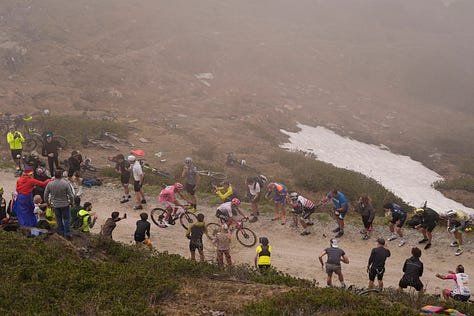

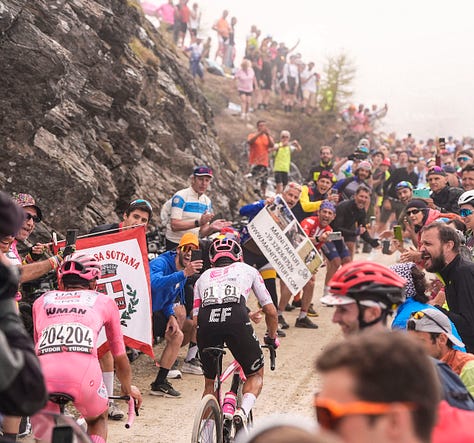
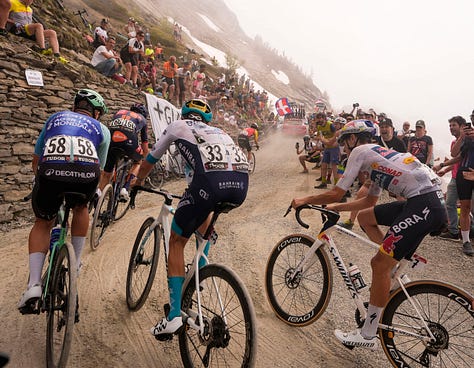
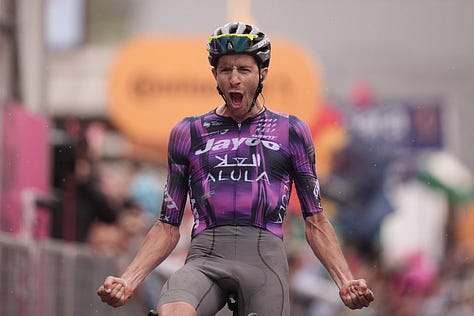

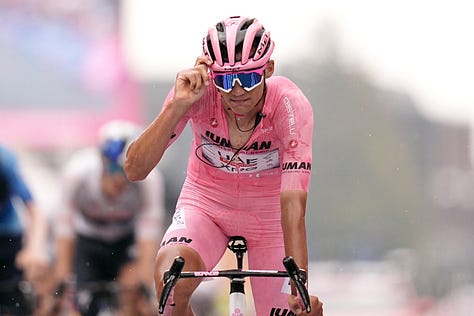
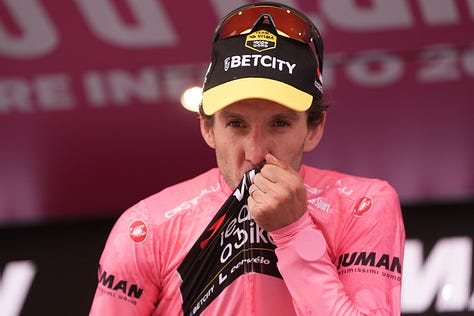
New episodes
• The Cycling Podcast Féminin’s May episode Irish Legs Are Smiling features Lara Gillespie of UAE-ADQ and Mia Griffin of Roland, plus a recap of the recent Spanish stage races. Listen wherever you get your podcasts.
• Our first post-Giro episode will be online later this week before attention turns towards the build-up to the Tour de France.





Great article!
Top notch piece that - nice one.